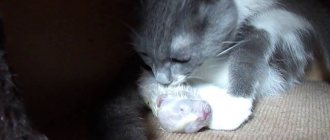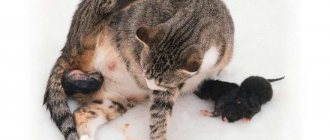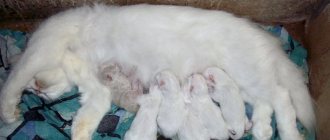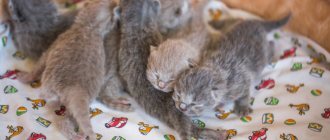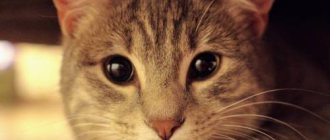Pregnancy detection
Healthy pets with a pedigree, veterinary passport and breeding value are allowed for breeding. In practice, a different picture can be observed. Domestic cats that freely visit the street find outbred males who do not have any regalia for mating.
It will not be possible to register the offspring from such matings in the breed club, so the kids will have to look for a new home for a very long time, and the kittens will be given away not for money, but for free. But this is the financial side of the issue, which, of course, should be foreseen in advance.
If mating is carried out under human control, and titled individuals participate in the process, the date of fertilization must be recorded. This will help determine the estimated date of birth of the offspring. When mating occurred without the knowledge of the cat owner, the gestational age can be determined by physiological signs and the changed behavior of the pet.
During pregnancy, the cat’s body undergoes restructuring, as evidenced by the following physiological signs:
- absence of heat. Pets over the age of 1 year estrus quite often (every 1-2 months), the onset of estrus can be recognized by characteristic behavior: purring, rubbing on the floor, night screams. If the cats' next calls do not occur as scheduled, it means the cat is pregnant;
- At about 3 weeks of pregnancy, the cat’s nipples swell and turn red;
- after the 4th week, you can notice rounded sides, and after the 6th week, the kittens can be felt moving in the womb.
To make sure that pregnancy has occurred, you need to show the animal to a veterinarian.
If mating proceeds according to a pre-planned plan, then the animals participating in the process must be checked for bacterial and infectious pathologies. In addition, before mating, animals must be treated for worms and other parasites.
Unplanned mating can be a reason for abortion. In the early stages of pregnancy this is allowed. Termination is also carried out for medical reasons, for example, if the pregnancy threatens the life and health of the pet.
Useful rules
There are several tips that, if followed, will not only help you carry and give birth to healthy babies for the first time, but will also keep you calm and on your nerves:
- A cat's pregnancy must be planned. And during the preparatory period, you need to consult a doctor, check for contraindications, possibly do a pelvic ultrasound and undergo some tests.
- A primiparous cat should maintain good physical activity , but without excessive stress. The objects she needs should be within reach so that the pet does not try to jump too high. There is no need to let a pregnant animal go outside unaccompanied.
- The future mother's nutrition should be complete and balanced . Deficiency of important elements should not be allowed: calcium, proteins, vitamins. Meat products and dairy products are required in the diet. Perhaps your doctor will recommend a vitamin complex. Do not neglect the recommendations if you want to get healthy offspring and keep your cat healthy.
- In the last days of pregnancy, purchase medications that may be needed during labor : Oxytocin to stimulate contractions, Gamavit to support the mother's body, Ringer's solution to prevent dehydration.
- If you are as inexperienced in feline birth as your pet, then you should think about professional help. If contractions occur, you can call the veterinarian at home, this will help prevent the occurrence of unforeseen complications.
- When assisting yourself during childbirth, carefully study the entire theoretical basis so that you are ready to provide assistance and do not panic at all. If health or life-threatening situations arise, seek medical help immediately.
Although labor is a natural process established by nature, the first time is always the most difficult, be it for a cat or for a person. After a couple of litters, your pet will become experienced enough to manage on her own. But it is better for a first-time mother not to be left without the support of a loving owner. And your task is to remain completely calm so that the inexperienced animal does not become even more nervous.
Nutrition tips
The onset of pregnancy in a cat requires a review of its diet. From the 4th week, nutrition should be enhanced. If the cat was previously fed 2 times a day, then it is transferred to fractional feeding. The fruits developing in the womb begin to put pressure on the organs of the digestive tract, so the cat is not able to eat the previous portion of food at one time (read what to feed a pregnant cat).
An incorrectly formulated diet leads to the cat losing weight, and in severe cases, suffering from exhaustion. Diet errors are dangerous not only for the pregnant woman, kittens can also suffer. A starving cat's offspring are born weak and developmentally delayed. Lack of vitamins and microelements leads to the following deviations:
- against the background of improper mineral metabolism, problems with bone tissue appear, expressed in the terrible condition of bones and teeth. Babies grow up with curvature of limbs (rickets);
- Developmental defects are observed due to a lack of vitamins in the diet. This also negatively affects the nervous system and internal organs;
- improper salt metabolism ends in pathology of the structure of the teeth;
- Miscarriages occur when there is a lack of protein and amino acids in the diet. Without these substances, fruits do not develop, and the body gets rid of them.
To get healthy offspring, you need to take care of the proper nutrition of your pet even before pregnancy. In the first month after fertilization, all organs and systems of babies develop, which is why it is so important to pay attention to diet.
You should not purchase various food additives or vitamins from pet stores without consulting a veterinarian. Only a specialist should recommend what should be included in the diet. An excess of minerals and vitamins is just as dangerous as their deficiency.
The weight of a cat is of great importance, so it is necessary to weigh it regularly and record the data in a notebook. Fluctuations in indicators may indicate deviations; only a veterinarian can dispel doubts.
An increased appetite and rapid weight gain can cause obesity. This condition is a risk factor during pregnancy and childbirth.
Normal pregnancy process, stages and timing
In a healthy animal, the process of pregnancy and childbirth occurs without the need for intervention or assistance.
In purebred, small, problem cats, childbirth may occur with complications. In more developed countries, there is a special profession - zooobstetrician, a specialist responsible for the favorable course of childbirth, preserving the life and health of the mother and offspring. In “our realities,” all responsibility falls on the shoulders of the owners and general veterinarians. On average, a normal cat pregnancy lasts 60–65 days, but the period can vary by 7–10 days depending on the breed and body composition of the expectant mother. Conventionally, pregnancy is divided into 3 stages:
- Mating – 3 weeks: after mating, the cat experiences swelling of the mucous membranes of the genital tract, but this does not guarantee pregnancy. Clear signs are observed from the third week: Drowsiness, decreased appetite and activity.
- Requires affection and attention.
- Vomiting (no more than 3 times a day, no longer than 2-3 days).
- Distinct pigmentation of the mammary glands - from light to bright pink.
- An enlarged uterus, which can be detected by a veterinarian by palpation.
- 4-6 weeks: Rapid growth of the “babies” and “rounding” of the cat. By week 6, the amount of fluid in the uterus increases, and the kittens begin to make their first movements.
- Kittens can be “felt” when gently palpated.
- The cat eats and sleeps more, otherwise behaves as usual.
- 7–9 weeks: Kittens are actively moving. The movements are clearly visible to the naked eye, especially if the cat is sleeping.
- Swelling of the mammary glands, release of colostrum.
- Some cats have a whitish vaginal discharge, which is normal.
- Increased anxiety and making a “den”.
Choosing a nest site
If you don't prepare a cozy and safe nest for your cat, she may find it on her own. In this case, it will be difficult to observe the birth process, because the cat can hide far under the sofa, behind a closet, in an open dresser drawer or some secluded place hidden from prying eyes.
About 2-3 weeks before giving birth, the pet begins to search for a nesting site. It is necessary not to miss this moment and offer the cat a good nest located within the owner’s reach. To arrange the nest, a durable box made of cardboard or plastic, which must be covered with a soft cloth, is suitable. This will make the habituation process easier, and the cat will be happy to rest in the nest. You will need another box in which to place newborn kittens.
During the birth process, the cat begins to discharge, so it is advisable to put a moisture-absorbing diaper in the box.
After the pets are born, the diaper is removed and the box is covered with natural cotton napkins. The fabric should not have any odors so as not to displease the cat. Until the umbilical cords fall off, the bedding must be changed at least once a day. Therefore, they prepare more of these napkins.
If before giving birth the cat realizes that the place for babies is not safe enough, she will move away from everyone. However, this cannot be allowed. After all, it is very difficult to help a woman in labor who is stuck under the sofa. In order not to frighten the cat away, it is better to allocate a separate room for labor, limiting access to children, other pets and strangers.
Caring for cats and kittens after birth
The box should be cleaned and soiled diapers replaced with clean ones. Place the box with the family in a quiet place. Observe behavior: if there was a simple birth, without complications, then the mother is calm, focused on licking and feeding the children. To eliminate stress and cessation of lactation, you will have to temporarily limit the visits of guests.
Further care for the cat that has given birth comes down to ensuring cleanliness and nutrition. It is recommended to keep the tray and bowls close to the box so that the mother is close to the offspring. Feed 5 times a day, give vitamins for newborn cats.
Dangerous symptoms
Excessive restlessness of the cat, copious discharge of an unusual color with an unpleasant odor should concern the owner. During a normal pregnancy, there should be no discharge before birth. The following symptoms warn of pathology:
- yellow-green discharge from the loop. Most likely, this is pus, provoked by the development of an infectious process in the uterus;
- the putrid smell of the discharge, its bright green tint occurs after the intrauterine death of kittens. Decomposition of the placenta is accompanied by unpleasant discharge;
- Blood may appear from the loop. This is also a dangerous signal warning of ruptured blood vessels or perforation of the uterus.
Pregnancy is a difficult test for the whole body. Stress leads to a decrease in immunity, so the cat can get a viral infection. Symptoms such as vomiting, diarrhea, sneezing, mucous or purulent discharge from the nose and eyes should be a reason to contact a veterinarian. Infectious diseases are fraught with the death of offspring or the formation of abnormalities.
The main signs of the imminent onset of labor:
- Anxiety, tremor, anorexia. Dilated pupils.
- Rapid breathing, sometimes with an open mouth.
- Digging, nest building.
- The temperature is about 36.7–37. The entire first stage of labor persists. By the 2nd stage it will return to normal.
- Vocalization in cats. They walk in circles and lick themselves.
- During this period, the cervix opens inside. There is no effort. There may be weak contractions that are mistaken for pushing.
- Another external manifestation of this stage of labor is the release of the mucus plug. It comes out when the cervix opens, and thick mucous discharge always comes out of the loop. It looks like a long thread hanging from a loop.
In cats, due to their cleanliness and immediate licking of anything that could dirty them, the removal of the plug can be difficult to notice. But often 1-24 hours before birth it can be noticed.
Baby's date of birth
The period of birth of kittens varies within 60-70 days after mating. Day 65-67 is considered optimal, but the body of each woman in labor is individual, so you should not rush to conclusions. If labor has not occurred by day 71, surgery is performed.
Decreased appetite on the eve of childbirth indicates the imminent arrival of babies. From this point on, it is necessary to conduct active preparations, call the veterinarian and arrange an appointment if the need arises.
The need to induce labor
The doctor must make such decisions. This will eliminate complications and death of the pet. If kittens are born within a few hours of each other, stimulation will be required. Make sure your actions will not harm the cat first.
You will need to massage your nipples and belly a little. Afterwards, Oxytocin is administered. This will be a good solution if there is no mechanical blockade. The doctor decides whether to prick the animal or not. After all, the wrong dosage can cause rupture of the cervix, and also provoke the death of kittens and their mother.
Childbirth kit
The process of giving birth to kittens is always exciting for owners. In order not to confuse anything in the chaos, you need to prepare in advance. The following items and tools should be placed near the nest:
- several disposable moisture-absorbing diapers;
- sterile gauze wipes, size 20x20 cm;
- a skein of thick silk thread that can be used to tie the umbilical cord;
- scissors for cutting the umbilical cord;
- stable container with water;
- small syringe;
- heating pad for babies;
- medical gloves;
- notebook;
- pen.
A first aid kit must be present. It contains:
- medical alcohol for disinfecting hands and instruments;
- hydrogen peroxide for treating the umbilical cord and occasional wounds;
- Streptocide, crushed into powder.
In addition, the first aid kit should contain ampoules with antibiotics, hormonal drugs and vitamins. This will allow emergency assistance to be provided to the woman in labor if necessary. The veterinarian will recommend the names of drugs for the first aid kit; after purchase, it is advisable to study the instructions and write down on a piece of paper what doses of the drug may be required.
Help for a woman in labor
In most cases, the owner's assistance during childbirth is not required. If the cat is confident in its actions and is not nervous, it is better to just watch the process. Inept human actions can only frighten the animal and increase stress.
The woman in labor is closely monitored.
Sometimes during contractions the cat goes to the litter box. Therefore, it is necessary to place the tray near the birth site and monitor that the cat does not give birth when visiting the toilet.
When a fetal sac appears in the cat's birth canal, it is necessary to transfer the pet to the nest.
Contractions usually last up to 12 hours. If contractions are weak, the break between them is up to 40 minutes. During strong contractions, the cat behaves restlessly, contractile movements of the peritoneum are visually noted.
Active licking of the genitals indicates the imminent approach of childbirth, while the cat’s breathing becomes heavier, and the pet may meow. The animal's body temperature 12-24 hours before labor can drop to 37ºC.
During childbirth, it is necessary to control the amount of placenta released. In order not to confuse anything in the turmoil, the time of birth of each baby and the expulsion of the placenta are recorded in a notebook. If after birth the number of kittens does not correspond to the number of afterbirths released, the cat must be taken to the veterinarian. Placences remaining in the womb can trigger the development of endometritis.
The apartment should be as quiet and calm as possible during childbirth. Excessive noise, strangers and the attention of other pets cause anxiety in the woman in labor, which contributes to a protracted labor, and in some cases can cause the death of the fetus.
As soon as your cat begins to strain, you need to thoroughly wash your hands and prepare. During a normal birth, the cat takes a position on its side and pushes. It takes several attempts (3-4) for the kitten to appear. When an amniotic sac appears in the birth canal, the cat breaks it and begins to actively wash the baby.
Licking continues until the kitten begins to breathe. Following the kitten, the placenta is expelled from the uterus. Many cats eat the afterbirth after gnawing off the umbilical cord. The substances that make up the placenta help stimulate labor, so you can allow your pet to eat them. It is advisable that no more than 4 pieces are eaten, otherwise the cat may develop diarrhea.
A newborn baby can speed up the appearance of new contractions. The mother pushes him to the nipples, where the kitten begins to suckle colostrum. The time period required for the birth of the next babies is approximately 20-40 minutes. For the second and subsequent fetuses, fewer attempts are required (2-3 for each).
The birth is considered complete if 2 hours have passed since the birth of the last baby.
In some cases, it happens that the baby is born a few hours later. This indicates weak labor.
The veterinary clinic offers to undergo an ultrasound to accurately know the number of future babies. It is better to do this in the last week before giving birth. Embryos that die in the uterus in the early stages tend to dissolve, so early studies are considered uninformative.
How to understand that a cat is giving birth?
Signs of labor:
- One or two days before giving birth, the cat becomes very restless. She can rush around the apartment, looking for a secluded place. This is absolutely normal, the cat’s nesting instinct is triggered, she is looking for a quiet, calm place where she can give birth to kittens, so that no one will touch or torment them.
- This is very important if you have small children in the house who regularly cuddle the cat. Accordingly, she does not want her babies to be pulled and tortured. It is advisable for you to help the cat if you do not want blood, mucus, and the remains of living tissue to be somewhere in a not very convenient and inaccessible place. For example, under the bathtub or behind the sofa.
- Therefore, it is in your interests to prepare a special house for your cat, that is, a box. For childbirth, it is best if you cut out the entrance somewhere at the level of the animal's chest. In this case, it is advisable to remove the roof, that is, remove it or simply turn the box over so that the top is open.
- Next, you need to lay either torn paper towels or old fabric on the bottom, which you won’t mind throwing away later. As soon as the cat decides on the place where she will give birth, she may begin to push.
- The most interesting thing is that these pets can delay the birth of babies for about 24 hours if they do not find a cozy and good place to give birth. Further, a cat can behave completely differently. Some pets become very excitable, and rub against the owner’s legs and meow heavily. Others, on the contrary, seclude themselves and do not want to be touched. We advise you not to bother your cat too much, so that she does not become aggressive and run away from the birthing area that you have prepared for her.
Newborn kitten
Possible complications
There are times when a cat cannot give birth. In order not to get confused in such a situation, it is important to understand what is a deviation and what is the norm. An urgent call to the veterinarian is necessary in the following cases:
- the first contractions last more than 12 hours;
- pushing lasts more than 60 minutes;
- More than 1-2 hours have passed since the first kitten appeared, but there is no more pushing;
- the fetus is stuck in the birth canal and has been there for more than 20 minutes, but the pushing has stopped.
Help provided unprofessionally can only do harm. Therefore, without hesitation, you should call a veterinarian at home. If the specialist’s arrival is delayed, you can try to help a cat whose pet is stuck in the birth canal. To do this, fill the syringe with petroleum jelly, remove the needle and generously lubricate the loop area.
You can pull the kitten out only during the next push. Excessive force is prohibited. This may result in injury to the birth canal and the baby.
What to do with kittens if there are a lot of them?
If a cat has given birth to many kittens, it will be difficult for her to care for her babies without your help. First of all, you need to organize proper and timely feeding of newborns. To do this, you will need special milk that replaces cat milk. You can buy it at a veterinary pharmacy.
For feeding you will need a special bottle with a tiny nipple. This accessory is also sold in pharmacies and specialized pet stores.
Newborn kittens need to be fed small portions every 2-3 hours. As you grow, the dosage is gradually increased. You can find out the exact amount of daily food for newborn kittens from your veterinarian. This issue is especially important to discuss with a specialist if the cat gave birth to premature kittens.
Resuscitation actions
Sometimes dead kittens are born. This usually occurs when the fetus is malpresented and has a long passage through the birth canal. In this case, you can try to resuscitate the kitten. The baby is wiped with a dry cloth or towel and placed on a heating pad or under a lamp. It is necessary to perform a closed cardiac massage and perform artificial respiration.
Before carrying out measures for ventilation of the lungs, it is necessary to free the nasal passages and oral cavity from amniotic fluid. If the cat itself has not licked the baby, use a small syringe or syringe without a needle. Only after clearing the airways do resuscitation measures begin.
If the revival measures were successful, the kitten begins to squeak. He is placed on a heating pad and left for 10-15 minutes to restore strength. When the baby actively moves his limbs, he is transferred to the mother's nipples. If the pet is lethargic, it is rubbed again and warmed under a lamp, observing the restoration of mobility.
If the kitten was born in the amniotic sac, and the mother went about her business, it is necessary to rupture the membrane of the bladder near the muzzle and remove fluid from the respiratory tract. After the baby has begun to breathe, the umbilical cord is cut at the thinnest point, leaving about 5 cm. The baby is rubbed.
Also watch the video of the entire process of giving birth to a cat with assistance:
How to deliver a cat at home?
Necessary things:
- Veterinarian number
- Plenty of paper towels and napkins
- Sterile gloves
- Antiseptic Chlorhexidine or Miramistin
- Pipette
- Scissors with blunt ends
- Small rubber bulb
The cat feeds the kittens.
Progress of labor:
- Now you will see contractions. Strange swaying movements are observed in the lower abdomen with a certain periodicity. In this case, the animal may become aggressive, worry, meow heavily, tear a box, blanket or sheet.
- Naturally, a pet may be in pain, this is how it should be, this is a natural process. After the first kitten is born, the cat begins to lick it, and also bursts the bubble if it has not burst itself. If somehow the cat forgot to do this, then you will have to break the bubble for her, because the kitten cannot breathe within its confines. It is necessary to help him get out and, if necessary, clear the airways of mucus.
- This can be done using a soft syringe or a regular pipette with a soft tip. Now all that remains is to observe and, if necessary, help the cat. After all the kittens are born, the places, that is, the placenta, are born.
- Please note that the number of places must correspond to the number of kittens. This is due to the fact that often the cat still has the placenta inside. It then contributes to the development of endometritis, severe inflammation is observed, as a result of which the cat can even die.
- Therefore, if you are missing one place, this is a reason to call the veterinarian. Before your cat gives birth, it is advisable to get several doctor numbers, call in advance and ask if they can come urgently if your pet needs help.
- If everything is in order and all kittens are born, do not rush to throw away the placenta and bladders. The cat must lick the kittens and be sure to eat all the places, that is, the placenta. The fact is that it contains Oxytocin, which helps the uterus contract, expel all contents, remnants of blood, mucus and places. With a lack of oxytocin, the uterus does not contract and inflammation is possible, resulting in the death of the animal within a few days.
Birth of kittens




